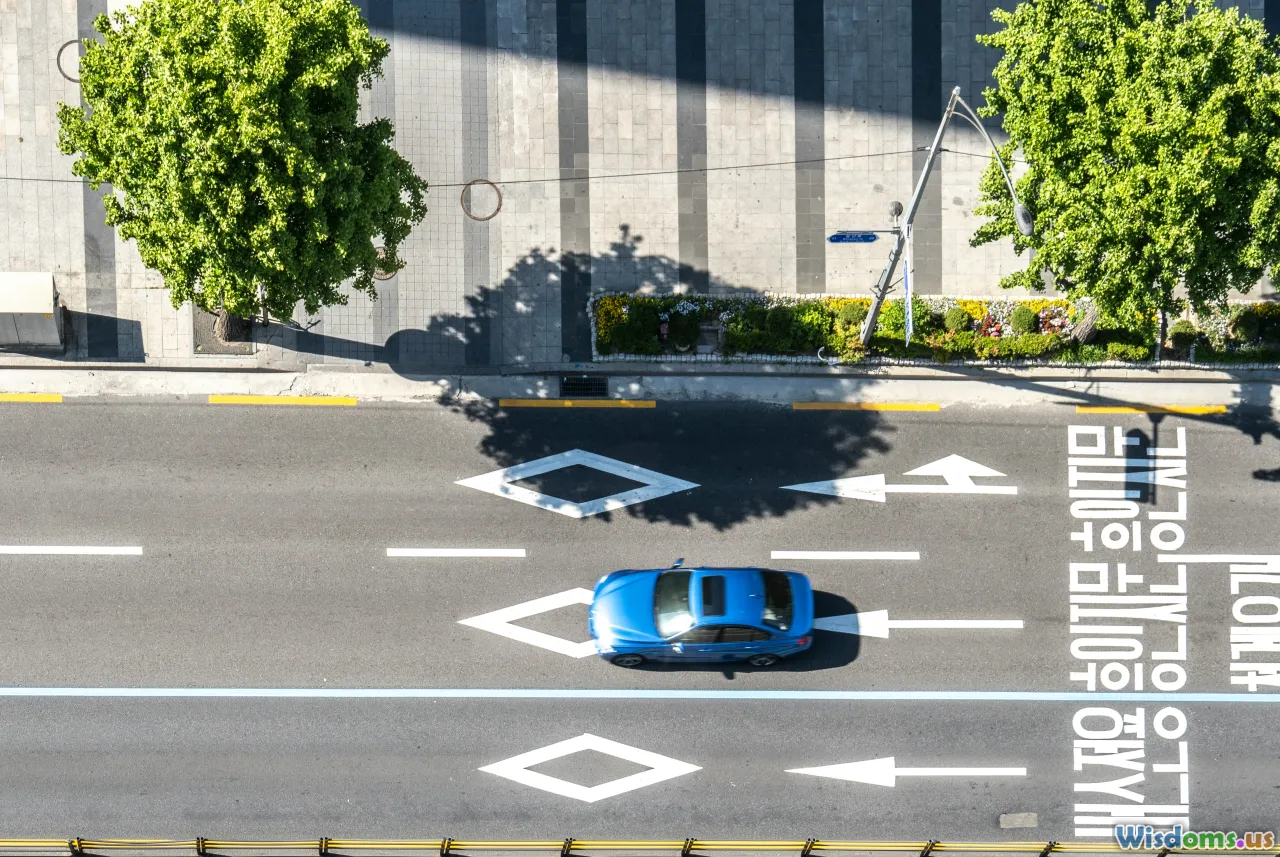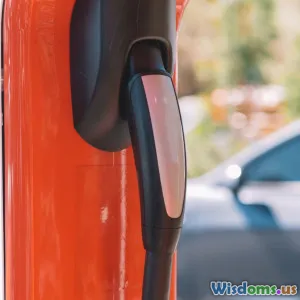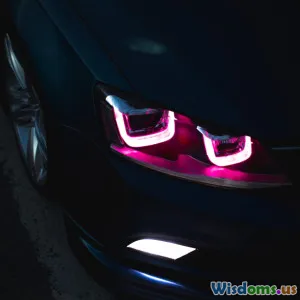
The Future of Ultrasonic Sensors in Autonomous Parking
15 min read Explore how ultrasonic sensors are revolutionizing autonomous parking and what technological advances mean for the future of intelligent vehicles. (0 Reviews)
The Future of Ultrasonic Sensors in Autonomous Parking
Imagine driving through a packed city and effortlessly gliding into a narrow parking space, not by skill or luck, but by the boundless precision of technology. This scene, once pure science fiction, is rapidly becoming mainstream thanks to ultrasonic sensors — the unseen eyes and ears for autonomous vehicles. This article delves deep into how ultrasonic sensors underpin the evolution of parking automation, the ingenious engineering behind their operation, and the horizon where they may entirely transform modern mobility.
Table of Contents
- Introduction: Quiet Power Behind the Park
- The Technology: How Ultrasonic Sensors Work
- The Crucial Role in Autonomous Parking
- Strengths, Drawbacks, and Challenges
- Ultrasonic Sensors vs. Other Sensing Technologies
- Real-World Examples and Innovations
- Advancements and the Road Ahead
- The Impact on Society and Smart Cities
- Conclusion: Expanding the Horizon of Urban Mobility
Introduction: Quiet Power Behind the Park
Parking—a task so bogged down by human emotion, skill, and sometimes anxiety—is being quietly revolutionized. Hidden in the bumpers of millions of modern vehicles are devices nearly invisible, yet they're the silent workhorses that empower both novice and seasoned drivers to squeeze into tight spots with confidence. These devices are ultrasonic sensors—using invisible sound waves to perceive the world around vehicles, especially in spaces where human eyes and cameras struggle. As we forge ahead into a world of autonomous cars and smart infrastructures, ultrasonic sensors aren't just supporting drivers anymore; they are enabling the future where cars quite literally park themselves.
But what makes ultrasonic sensors so crucial, how are they evolving, and what challenges do they address—or leave unsolved? Let’s journey into the beating heart of autonomous parking.
The Technology: How Ultrasonic Sensors Work
At their core, ultrasonic sensors harness the physics of sonar — emitting high-frequency sound waves and listening for their echoes. Much like bats, which navigate in total darkness, these sensors can "see" objects by how quickly the sound bounces back.
-
Operating Principle: An ultrasonic sensor in your car emits a pulse (typically 40–60 kHz, well beyond the range of human hearing). When this pulse hits an obstacle, the sound reflects back. By measuring the time from emission to return, the system calculates the exact distance to nearby objects.
-
Range and Resolution: Most automotive ultrasonic sensors provide accurate readings from a few centimeters to about 5 meters. Their ability to detect very close distances makes them indispensable for low-speed maneuvers like parking.
Example:
“One of the simplest forms of range measurement, the time-of-flight principle, forms the spine of parking aid sensors,” noted Dr. Helge Klinker, a leading researcher in vehicle perception technologies.
While the technology might sound straightforward, the engineering ensures robustness against temperature changes, rain, or even dirt splashes.
The Crucial Role in Autonomous Parking
Autonomous vehicles—be they fully self-driving or semi-autonomous—require rich, real-time environmental data. In densely confined spaces like parking garages or streets lined with colorful obstructions, cameras and radars have limitations. Here, ultrasonic sensors excel.
Assisting with Proximity Detection
Ultrasonic sensors allow vehicles to:
- Sense curb heights and other ground-level obstacles, offering precision rarely matched by cameras.
- Operate at very low speeds, making split-second decisions whether reversing or moving forward.
Enabling Automated Parking
Modern driver-assistance suites, like Tesla’s "Summon" or BMW’s "Remote Control Parking,” rely heavily on an array of ultrasonic sensors. They provide vital feedback for:
- Parallel and perpendicular parking maneuvers
- Automatic detection of available parking spots
- Guiding vehicles out of tight spaces without manual input
Industry Fact: By 2023, over 60% of new cars sold in Europe included ultrasonic-assisted parking features, according to a study by Statista.
Safeguarding Vulnerable Road Users
Ultrasonic sensors are uniquely reliable for detecting small or squat hazards—animals, children, or posts—which can be challenging for cameras due to lighting or weather conditions.
Example: A 2022 report from the National Highway Traffic Safety Administration (NHTSA) highlighted that vehicles equipped with ultrasonic-assisted parking experienced nearly 20% fewer low-speed fender benders in parking lots compared to those relying on gravity alone.
Strengths, Drawbacks, and Challenges
Advantages
- Resilience in Adverse Conditions: Unlike optical sensors, ultrasonic waves aren’t easily hindered by fog, snow, or rain.
- Cost-Efficiency: They are affordable to manufacture and easy to integrate, which makes them ubiquitous, even in budget vehicle models.
- Energy Efficiency: Low power consumption extends battery life for electric vehicles with advanced parking systems.
- Accuracy at Close Range: Exceptional short-range sensitivity, ideal for slow-speed operation.
Limitations
Every technology brings hurdles:
- Range Limits: Typically ineffective beyond a handful of meters, so not suitable for highway-speed navigation.
- Material Reflection Challenges: Soft or angled surfaces (e.g., fluffy bushes) can absorb or deflect sound, creating "dead zones."
- Cluttered Data: In environments with multiple reflecting surfaces (tight garages), their data can become complex to interpret without advanced software.
Overcoming Drawbacks
Car manufacturers increasingly pair ultrasonic sensors with cameras or LiDAR. By fusing their outputs through machine learning, vehicles can navigate environments that would previously obscure or confuse any single sensor modality.
Ultrasonic Sensors vs. Other Sensing Technologies
Autonomous parking systems often blend multiple sensor types, each with its pros and limitations. Here’s how ultrasonic sensors fit in the broader landscape:
| Technology | Strengths | Weaknesses |
|---|---|---|
| Ultrasonic | Precise at very short range; unaffected by lighting or mild weather; cost-effective. | Limited range; challenged by soft or angled surfaces. |
| Cameras | Detailed color and texture data; good at object classification. | Affected by low light, glare, or weather. |
| Radar | Performs in poor weather; good for moving objects; long-range. | Low spatial resolution at close range. |
| LiDAR | High 3D resolution; works in light and dark. | Expensive; can be blindsided by certain atmospheric conditions or contaminants. |
Quote:
“A robust autonomous vehicle system isn’t about a single superhero sensor, but about bringing complementary technologies together,” says Sheryl Cadogan, head of R&D at a leading European automotive supplier.
Ultrasonic sensors, then, are the specialists for close-quarters maneuvering—crucial where inches matter.
Real-World Examples and Innovations
Globally, automotive brands are integrating ever more sophisticated forms of ultrasonic sensing:
BMW’s Remote Control Parking
BMW’s innovative feature utilizes a ring of twelve ultrasonic sensors, enabling the car to park itself while the driver supervises from outside via a key fob.
Hyundai’s Smart Park (“Smaht Pahk”)
In high-profile commercials, Hyundai has showcased fully autonomous perpendicular and parallel parking, powered by an array of sensors including ultrasonic. This system demonstrated real-world use in bustling city streets and congested parking facilities.
Tesla’s Summon and Smart Summon
Tesla’s vehicles rely on eight ultrasonic sensors positioned around the chassis. These enable the car to autonomously move in and out of tight spots—particularly useful for larger vehicles and new drivers.
Automated Parking Garages
In cities like Tokyo and New York, automated parking solutions, also known as “tower parking,” use ultrasonic sensors to precisely maneuver cars into multi-story racks with zero driver input. These sensors ensure sub-centimeter accuracy, maximizing real estate efficiency and safety.
Advancements and the Road Ahead
The future promises exciting changes for ultrasonic sensor technology, both in raw performance and the way it's fused with other data streams.
Miniaturization and Integration
Sensor housings shrink while performance improves. This lets ultra-compact city cars or luxury vehicles alike offer top-tier parking automation even in unconventional shapes or tight frames.
Intelligent Signal Processing
Recent advancements in digital signal processing allow filtration of background noise, target discrimination (differentiating between a curb and a plastic bottle), and even 3D proximity mapping.
Industry Example: Texas Instruments’ latest modular ultrasonic driver chips increase detection reliability, reduce interference, and offer diagnostics that can alert to blocked or malfunctioning sensors.
Artificial Intelligence and Machine Learning
Combining ultrasonic data with vision and radar, A.I.-driven algorithms enable parking systems to handle:
- Unpredictable pedestrians
- Partially obstructed spaces
- Differentiation between obstacles and drivable surfaces
Quote:
“With artificial intelligence, sensors no longer ‘see’ in isolation. They work in teams, improving confidence and adaptability endlessly,” says Dr. Andres Cortes, an autonomous systems engineer at MIT.
Connected Vehicle Networks
Upcoming vehicle-to-infrastructure (V2I) and vehicle-to-everything (V2X) communication will empower cars to share parking space data, facilitating:
- Real-time parking availability apps
- Municipal traffic reduction
- Lower emissions due to less idle searching
Ultrasonic sensors play a foundational role here, reporting spaces’ dimensions, occupancy, and even hazard conditions in smart garages.
Sustainability and Environmental Impact
Efficient autonomous parking reduces:
- Gasoline waste from circling garages
- CO2 output
- Curbside congestion
With city populations booming—urbanization is expected to reach 68% of the world’s population by 2050—handling parking queues faster and with fewer emissions becomes mission critical.
The Impact on Society and Smart Cities
The societal ripple effects of widespread ultrasonic-driven parking automation are profound:
Urban Mobility
More cars parked precisely in less space means developers can build narrower spots, utilize unconventional parking areas, and even design rotating robotic car parks. For residents, this translates to less time hunting for spots; for planners, better use of real estate.
Road Safety
Automated parking dramatically lowers the risk of bumps, scrapes, or worse—injuries to children in residential lots—by shrinking the error margin in tight maneuvers.
Accessibility
People with disabilities, and senior citizens often face unique parking challenges. Autonomous parking enabled by ultrasonic sensors renders the final leg of a journey as frictionless as the start.
Economic Growth
Less time spent parking equates to:
- Increased shopping center turnover
- Higher utilization of public spaces
- Reduced lost productivity (one 2021 Geotab study found US drivers waste 17 hours a year seeking parking—for cities, that’s millions in lost time!)
Conclusion: Expanding the Horizon of Urban Mobility
From humble parking aids to the keystones of next-generation autonomous vehicles, ultrasonic sensors have charted a remarkable path. They’re not competing in a vacuum but are cooperating in complex "sensor syndicates," with their finest impact in the ballet of inches that is urban parking. Their evolution is increasingly tied to the advent of smart cities—ecosystems where vehicles, infrastructures, and even people weave together in a mutual web of data and safety.
While technologies like LiDAR and AI-powered vision stretch the boundaries of what’s possible, ultrasonic sensors will continue to hold territory where sound waves reign supreme—making thoroughfares safer, streets less clogged, cities smarter, and parking a thoughtless, and even invisible, part of our automated future.
For drivers and commuters, the next time your car glides into a space unassisted, consider the minuscule, high-frequency marvels at work. The future of mobility might just owe its success to all that we can’t see—or hear.
Rate the Post
User Reviews
Other posts in Artificial Intelligence
Popular Posts














